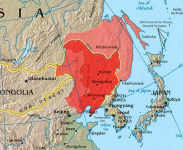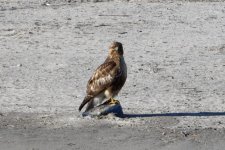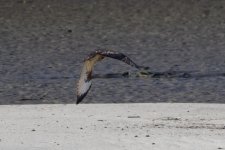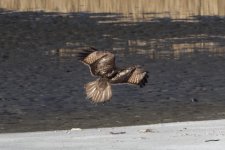-
Welcome to BirdForum, the internet's largest birding community with thousands of members from all over the world. The forums are dedicated to wild birds, birding, binoculars and equipment and all that goes with it.
Please register for an account to take part in the discussions in the forum, post your pictures in the gallery and more.
You are using an out of date browser. It may not display this or other websites correctly.
You should upgrade or use an alternative browser.
You should upgrade or use an alternative browser.
Upland Buzzard? Gangneung, South Korea (9/2/21) (1 Viewer)
- Thread starter sandwich311
- Start date
More options
Who Replied?Deb Burhinus
Used to be well known! 😎

The lack of feathered tarsus (among other things) say not - perhaps japonicus or even wintering refectus/burmanicus - I am not sure what Common Buzzard complex options there are in Korea or even how you would reliably separate the latter in that region.
Jeff Hopkins
Just another...observer

Japonicus is the expected buteo in Korea. Plenty of recent sightings in eBird, too.
Deb Burhinus
Used to be well known! 😎

Japonicus would be the assumption- however Burmanicus may also winter in the Korean peninsula (and does according to some literature) - presumably from Central China or Manchuria breeding populationsJaponicus is the expected buteo in Korea. Plenty of recent sightings in eBird, too.
Post in thread ''Himalayan Buzzard''
https://www.birdforum.net/threads/himalayan-buzzard.132483/post-2528582
- it’s hard to find specific literature on the exact breeding and winter range of burmanicus perhaps because the taxonomy of east Asian buteos is complex and partly unresolved?

I believe several of these have been redefined recently and that might be part of the problem.- it’s hard to find specific literature on the exact breeding and winter range of burmanicus perhaps because the taxonomy of east Asian buteos is complex and partly unresolved?
Niels
Please see post 9 for retraction
Last edited:
Deb Burhinus
Used to be well known! 😎

Feel free to clarify Niels.I believe several of these have been redefined recently and that might be part of the problem.
Niels

Some resources call "Buteo burmanicus" for "Buteo refectus" and this has in the not too far past been considered conspecific with either Eastern Buzzard or Common Buzzard. I believe that there has even been some reshuffling of subspecies after the original split.
Niels
Please see post 9 for retraction
Niels
Please see post 9 for retraction
Last edited:
Deb Burhinus
Used to be well known! 😎

w
Can you be more specific on this please - are you referring to hodgsoni - ?
- which wouldn’t apply to Korea since hodgsoni is a nomenclature that has been given to plumipes, a dark morph population of Himalayan buteos https://www.researchgate.net/publication/267922638_A_new_name_for_a_buzzard_from_the_Himalayas
Are there more recent taxonomic changes to japonicus or burmanicus than the above?
- (I mean specifically North Eastern China and Japanese buteos)
Yes, that’s actually ‘old’ news to some extent - treatment hereSome resources call "Buteo burmanicus" for "Buteo refectus" and this has in the not too far past been considered conspecific with either Eastern Buzzard or Common Buzzard
I believe that there has even been some reshuffling of subspecies after the original split.
Can you be more specific on this please - are you referring to hodgsoni - ?
- which wouldn’t apply to Korea since hodgsoni is a nomenclature that has been given to plumipes, a dark morph population of Himalayan buteos https://www.researchgate.net/publication/267922638_A_new_name_for_a_buzzard_from_the_Himalayas
Are there more recent taxonomic changes to japonicus or burmanicus than the above?
- (I mean specifically North Eastern China and Japanese buteos)
Last edited:

I am going to retract most of what I said in this thread: I thought I remembered a specific thread here in birdforum, but searching I cannot find it. The only thing I want to still point out is that Clements and H&M4 uses "refectus" for what IOC calls "burmanicus ". I also thought there was some discussion somewhere of what was correct, but cannot find that either.
Niels
Niels
Deb Burhinus
Used to be well known! 😎

No need to retract anything Niels - I can’t see you being incorrect with anything and as for your last post, I believe you may be referring to my favourite thread on Birdforum of all time the utterly impenetrable and almost incomprehensible ‘Himalayan Buzzard’ thread 😅
(The link to which I already posted above)

 www.birdforum.net
www.birdforum.net
(The link to which I already posted above)

'Himalayan Buzzard'
Maybe I'm missing something here, but is there any good reason not to call this a dark morph hemilasius? Laurent - various reasons: too small (although difficult to interpret from Hodgson's measurements), partially feathered (rather than 3/4) tarsus, lack of greyer flight feathers on...
Deb Burhinus
Used to be well known! 😎

So Rob,
Apologies for all the detours but we can summarise as follows:
Your buzzard is not an Upland Buzzard for the reasons stated in #1. Pinning down wether it is a Japanese B.b.japonicus or Himalayan B.b.burmanicus/refectus is not going to be possible on this one image imo. Japanese is the most obvious assumption but in winter, Himalayan Buzzards also may be an option. Separating them can anyway be very difficult and while I personally have no experience with japonicus or South Korea so am unfamiliar with the local ‘types’, I have no experience with Chinese breeding populations of burmanicus either only those found in NW India. Someone more familiar with the local plumage variants may be able to help you further but without a proper view of the underwing or structure, I think going any further with that would be a very difficult task.
I hope the discussion has nether the less been helpful.
Deb
Apologies for all the detours but we can summarise as follows:
Your buzzard is not an Upland Buzzard for the reasons stated in #1. Pinning down wether it is a Japanese B.b.japonicus or Himalayan B.b.burmanicus/refectus is not going to be possible on this one image imo. Japanese is the most obvious assumption but in winter, Himalayan Buzzards also may be an option. Separating them can anyway be very difficult and while I personally have no experience with japonicus or South Korea so am unfamiliar with the local ‘types’, I have no experience with Chinese breeding populations of burmanicus either only those found in NW India. Someone more familiar with the local plumage variants may be able to help you further but without a proper view of the underwing or structure, I think going any further with that would be a very difficult task.
I hope the discussion has nether the less been helpful.
Deb
Last edited:
johnallcock
Well-known member
I find the taxonomy of Asian Buteos to be very confusing. But my understanding was the the currently defined Himalayan Buzzard (refectus/burmanicus/whatever it currently is) was generally considered to be a resident/short distance migrant in the Himalayas and nearby mountains, and only reaching as far east as Yunnan in SW China (even then with a bit of uncertainty). Birds of the World gives a range map from Pakistan to NE India, IOC lists the range as 'Himalayas'.
On this basis, it seems like a highly unlikely species to occur in Korea.
On this basis, it seems like a highly unlikely species to occur in Korea.
Deb Burhinus
Used to be well known! 😎

Hi John - I was referring to the buteo races breeding in Northern/Central China and Manchuria - which apparently winter in Southern China and SE Asia (and possibly South Korea) - distinct from the breeding populations in NE India/Nepal. As Richard Klim refers to here
Post in thread ''Himalayan Buzzard''
https://www.birdforum.net/threads/himalayan-buzzard.132483/post-2528582
“[Burmanicus/refectus is believed to be a migrant from a northern breeding range including Manchuria.]” (in red below for those like me whose geography is appalling 😉)

There are clearly several distinct populations of ‘burmanicus/refectus’ - are you saying in your view, they are all restricted to the Himalayan chain?
https://www.researchgate.net/profil...m-the-Himalayas.pdf?origin=publication_detail States that:
“We are satisfied that burmanicus is a migrant from a northern breeding range including Manchuria.“
It‘s the above populations that I was suggesting may (??) winter further South in the Korean peninsular
Jalid further states that the ” breeding distribution of Himalayan buzzards extends far to the north in Chinese mountains and it is almost certain that buzzards there are more migratory compared to the Himalaya.” Although he was referring to difficulty in separating on plumage wintering japonicus and burmanicus in Thailand and the occurance of Himalayan in SE Asia not those wintering in the lower latitudes of E Asia! (sorry lost the link will try and recover it) EDIT HERE
Post in thread 'Buteo identification north Thailand'
https://www.birdforum.net/threads/buteo-identification-north-thailand.371194/post-3800127
He also states “Himalayan Buzzard and East Asian Buzzard (or whatever you like to call those buzzards of japonicus group, which breed in eastern Asia and spend their winter in S China and SE Asia) are very difficult to separate. I have tried to learn but only found out some average tendencies. Those average distinctions have not helped me to understand what is the relative status of Himalayan and East Asian Buzzards in SE Asia.”
I too was referring to IOC range maps on an Indian Buzzard thread and ruling out japonicus on the Southern Indian continent (West of the Himalayan chain). At the time, Jalid pointed out the boundaries of these races were unresolved (as is the taxonomy) but that wasn’t reflected in the range maps. I therefore got the impression (in error?) that due to the difficulties in separating the two races on some of the plumage types, (ie the paler individuals), ID of Himalayan outside of its breeding range in Asia was therefore probably unreliable some/much? of the time.. (Which floored me completely).
It really doesn’t help when sources and literature can’t agree - that’s partly the source of confusion perhaps!?
Of course if all races breeding east of the spine of the Himalayan chain were lumped into ‘Japanese Buzzard‘ and all those West of the spine, lumped into vulpinus/burmanicus Himalayan Buzzard, would that simplify anything? Or perhaps that’s already being done? However it still wouldn’t resolve the issue of identifying wintering Himalayan/Eastern away from their breeding grounds.
Btw - interesting treatment update for SE Asia (not Korea!)

 singaporebirdgroup.wordpress.com
singaporebirdgroup.wordpress.com
Post in thread ''Himalayan Buzzard''
https://www.birdforum.net/threads/himalayan-buzzard.132483/post-2528582
“[Burmanicus/refectus is believed to be a migrant from a northern breeding range including Manchuria.]” (in red below for those like me whose geography is appalling 😉)

There are clearly several distinct populations of ‘burmanicus/refectus’ - are you saying in your view, they are all restricted to the Himalayan chain?
https://www.researchgate.net/profil...m-the-Himalayas.pdf?origin=publication_detail States that:
“We are satisfied that burmanicus is a migrant from a northern breeding range including Manchuria.“
It‘s the above populations that I was suggesting may (??) winter further South in the Korean peninsular
Jalid further states that the ” breeding distribution of Himalayan buzzards extends far to the north in Chinese mountains and it is almost certain that buzzards there are more migratory compared to the Himalaya.” Although he was referring to difficulty in separating on plumage wintering japonicus and burmanicus in Thailand and the occurance of Himalayan in SE Asia not those wintering in the lower latitudes of E Asia! (sorry lost the link will try and recover it) EDIT HERE
Post in thread 'Buteo identification north Thailand'
https://www.birdforum.net/threads/buteo-identification-north-thailand.371194/post-3800127
He also states “Himalayan Buzzard and East Asian Buzzard (or whatever you like to call those buzzards of japonicus group, which breed in eastern Asia and spend their winter in S China and SE Asia) are very difficult to separate. I have tried to learn but only found out some average tendencies. Those average distinctions have not helped me to understand what is the relative status of Himalayan and East Asian Buzzards in SE Asia.”
I too was referring to IOC range maps on an Indian Buzzard thread and ruling out japonicus on the Southern Indian continent (West of the Himalayan chain). At the time, Jalid pointed out the boundaries of these races were unresolved (as is the taxonomy) but that wasn’t reflected in the range maps. I therefore got the impression (in error?) that due to the difficulties in separating the two races on some of the plumage types, (ie the paler individuals), ID of Himalayan outside of its breeding range in Asia was therefore probably unreliable some/much? of the time.. (Which floored me completely).
It really doesn’t help when sources and literature can’t agree - that’s partly the source of confusion perhaps!?
Of course if all races breeding east of the spine of the Himalayan chain were lumped into ‘Japanese Buzzard‘ and all those West of the spine, lumped into vulpinus/burmanicus Himalayan Buzzard, would that simplify anything? Or perhaps that’s already being done? However it still wouldn’t resolve the issue of identifying wintering Himalayan/Eastern away from their breeding grounds.
Btw - interesting treatment update for SE Asia (not Korea!)

Eastern Buzzard – Singapore Bird Group
Posts about Eastern Buzzard written by TAN Gim Cheong
Last edited:
sandwich311
Well-known member
Thanks everyone for your insightful responses. I have learned a lot about the buzzards in this area.
All the best.
All the best.
Deb Burhinus
Used to be well known! 😎

The more one researches buteos in Asia, the more one ‘unlearns’!Thanks everyone for your insightful responses. I have learned a lot about the buzzards in this area.
All the best.

The above is posted in a thread by Andy in the Taxonomy forum, and the authority making this change is IOC. That seems to indicate that there now will be consensus about using B. refectus for Himalayan Buzzard.Feb 12 Change scientific name of Himalayan Buzzard from Buteo burmanicus to B. refectus.
Niels
Users who are viewing this thread
Total: 2 (members: 0, guests: 2)






